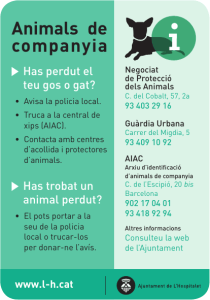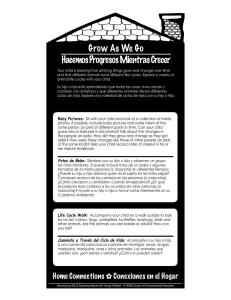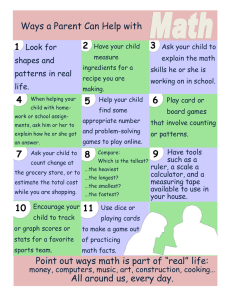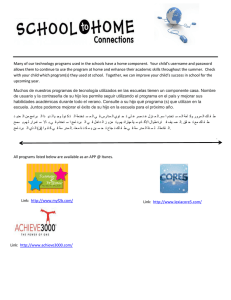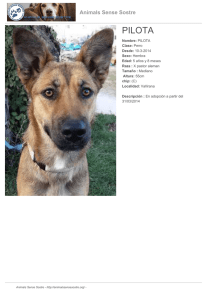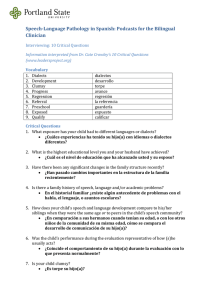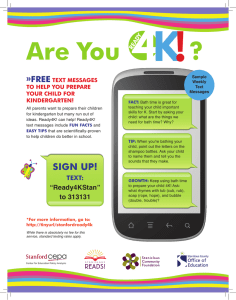I See Animals Hiding
Anuncio
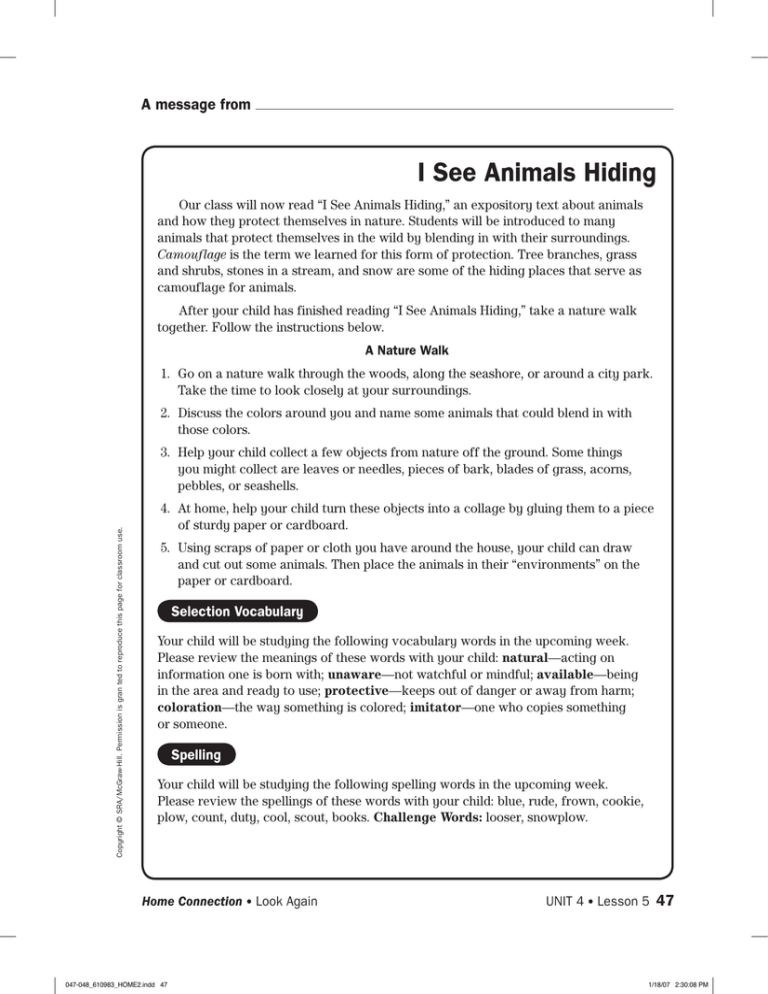
A message from I See Animals Hiding Our class will now read “I See Animals Hiding,” an expository text about animals and how they protect themselves in nature. Students will be introduced to many animals that protect themselves in the wild by blending in with their surroundings. Camouflage is the term we learned for this form of protection. Tree branches, grass and shrubs, stones in a stream, and snow are some of the hiding places that serve as camouflage for animals. After your child has finished reading “I See Animals Hiding,” take a nature walk together. Follow the instructions below. A Nature Walk 1.Go on a nature walk through the woods, along the seashore, or around a city park. Take the time to look closely at your surroundings. 2.Discuss the colors around you and name some animals that could blend in with those colors. Copyright © SRA/McGraw-Hill. Permission is gran ted to reproduce this page for classroom use. 3.Help your child collect a few objects from nature off the ground. Some things you might collect are leaves or needles, pieces of bark, blades of grass, acorns, pebbles, or seashells. 4.At home, help your child turn these objects into a collage by gluing them to a piece of sturdy paper or cardboard. 5.Using scraps of paper or cloth you have around the house, your child can draw and cut out some animals. Then place the animals in their “environments” on the paper or cardboard. Selection Vocabulary Your child will be studying the following vocabulary words in the upcoming week. Please review the meanings of these words with your child: natural—acting on information one is born with; unaware—not watchful or mindful; available—being in the area and ready to use; protective—keeps out of danger or away from harm; coloration—the way something is colored; imitator—one who copies something or someone. Spelling Your child will be studying the following spelling words in the upcoming week. Please review the spellings of these words with your child: blue, rude, frown, cookie, plow, count, duty, cool, scout, books. Challenge Words: looser, snowplow. Home Connection • Look Again 047-048_610983_HOME2.indd 47 UNIT 4 • Lesson 5 47 1/18/07 2:30:08 PM Un mensaje de I See Animals Hiding Nuestra clase ahora leerá “I See Animals Hiding”, un texto expositivo sobre animales y sobre cómo se protegen en la naturaleza. Se les presenta a los estudiantes a muchos animales en su hábitat natural que se protegen al adaptarse a su entorno. Camuflaje es el término que aprendimos para este tipo de protección. Entre los escondites que sirven como camuflaje para los animales veremos ramas, pastos, arbustos, piedras en un arroyo y nieve. Cuando su hijo(a) haya terminado de leer “I See Animals Hiding”, den juntos una caminata para explorar la naturaleza. Siga las siguientes instrucciones. Caminata para explorar la naturaleza 1.Den una caminata para explorar la naturaleza, ya sea por el bosque, la playa o algún parque de la ciudad. Tómense el tiempo de mirar detenidamente a su alrededor. 2.Hablen de los colores que los rodean y nombren animales que podrían adaptarse y cambiar a esos colores. 3.Ayude a su hijo(a) a juntar unos cuantos objetos de la naturaleza, de los que encuentren en el suelo. Algunas cosas que pueden juntar son hojas o agujas de pino, pedazos de corteza, pedacitos de pasto, bellotas, piedritas o conchas. 5.Con recortes de papel o tela que tenga en casa, su hijo(a) puede dibujar y recortar algunos animales y colocar los animales en sus respectivos entornos en la cartulina o cartón. Vocabulario de la selección La próxima semana su hijo(a) estudiará las siguientes palabras de vocabulario. Por favor, revise junto a su hijo(a) los significados de estas palabras: natural (natural— actuar con información que uno ya tiene cuando nace); unaware (inconsciente—no reflexiona, ignorante); available (disponible—listo para ser utilizado); protective (protector(a)—que resguarda del peligro o del daño); coloration (coloración—la forma en la que algo toma color); imitator (imitador—uno que copia algo de alguien). Ortografía La próxima semana su hijo(a) estudiará las siguientes palabras de ortografía. Por favor, revise junto a su hijo(a) la escritura de estas palabras: blue, rude, frown, cookie, plow, count, duty, cool, scout, books. Palabras difíciles: looser, snowplow. 48 Unidad 4 • Lección 5 047-048_610983_HOME2.indd 48 Copyright © SRA/McGraw-Hill. Permission is granted to reproduce this page for classroom use. 4.Al regresar a casa, ayude a su hijo(a) a hacer un montaje con todos estos objetos de la naturaleza, pegándolos en una cartulina o un cartón. Mira otra vez • Home Connection 1/18/07 2:30:09 PM
